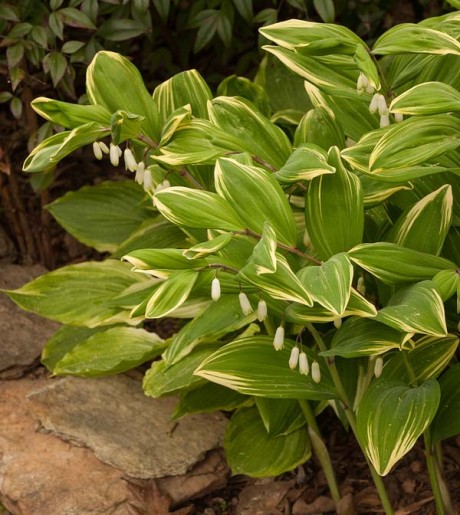Sing a song of Solomon’s seal
Plus garden to do's for April & May
By L.A. Jackson"Graceful" is the word that best describes Solomon's seal, a pendulous, deer-resistant perennial that can add three-season interest to a shady garden. In the spring, its rows of bell-shaped, light green to white flowers delightfully dangle in pairs underneath the arching limbs, which, even when not in flower, bring elegance to the summer garden. In the summer, blue, fleshy berries hang below the curved branches, and then, the foliage salutes the coming autumn by turning a pleasing butter yellow.
This pretty plant gets its name from the round scars on the rhizomes at a point just above ground where the stems originate. The scars are swirls of lines, which with some imagination, do resemble the wax seals ancient nobility such as King Solomon would have used to authenticate documents.
"Solomon's seal" is a collective name for over 60 species growing in North America, Asia and Europe. One of the more common, the native Polygonatum biflorum inhabits the woodlands of North Carolina as well as other parts of the eastern United States, and makes a flowing statement in cultivated gardens with pendulous branches reaching up to 3 feet tall and 3 feet wide.
If a shady nook is in need of some "Yipes! Stripes!" the widely available variegated Solomon's seal (P. odoratum 'Variegatum') is the answer. Of similar stature and form as our native Solomon's seal, this Eurasian import has cream-colored streaks along the lengths of each leaf, which help to break up the sea of green common in southern shade gardens.
In ideal growing conditions, a store-bought Solomon's seal will slowly colonize to form masses of arching, eye-catching plants. Such conditions include an acidic, rich medium with a strong organic base to help retain an even supply of moisture and a site located in part to full shade.
Garden To Do's
April
- Want to try some kitchen chemistry in the veggie patch? When setting pepper plantlets out, place five unburnt match heads in each planting hole. The sulfur, phosphorus and other elements from the matches help develop stronger plants, which, in turn, produce more peppers.
- If your house cactus, African violet or amaryllis has become root-bound in its container, don't repot — the cramped quarters will encourage blooming.
- Placing a rain gauge in the garden adds more precision to your decisions to water plants this spring and summer.
- Nesting activity will be at the max this month, so, while filling the bird feeder regularly, also include some 3-inch long pieces of string or yarn to help with nest-building.
May
- Concerned about sowing pinhead-sized seeds too thickly? Mix them with a little sand, pour into an unused salt shaker, and sprinkle the seeds into their proper place in the garden.
- Annuals such as zinnias, salvias and petunias can become long and lanky, but pinching the plants back when they are about 6 to 8 inches tall will encourage bushier growth.
- Water is critical for garden-grown onions and cucumbers. If not watered regularly, onions won't mature to their proper, plump size, and cukes will develop a bitter taste.
- When planting tomatoes, take advantage of the warm soil close to the surface (which induces strong root growth) by setting the plantlets parallel to the ground in well-worked trenches rather than in deep holes, and burying all but the upper 4 inches of each plant.
-
Share this story:



